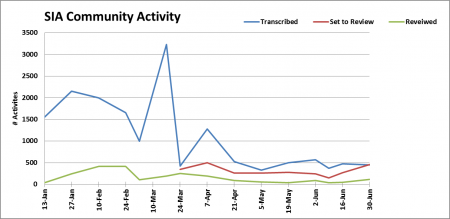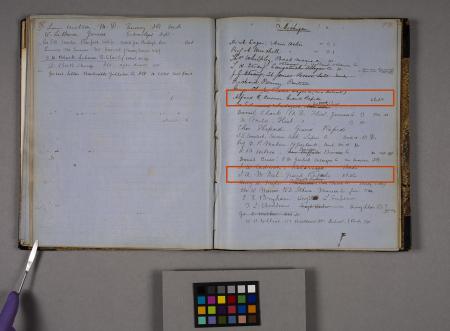The Smithsonian Transcription Center has been around for over a year and the community of #volunpeers who expertly transcribe and review texts has grown and grown. This summer, my project was to get to know the community of #volunpeers who contributed to Smithsonian Institution Archive’s projects by looking through pages and pages of data reflecting the quantity and frequency of completing transcription and review activities. Here is a graph of the activity of Archives #volunpeers during the first 6 months of the year.

To understand why activity was high during certain moments and low during others, and to explore how the Transcription Center operates as a system with multiple moving parts, I took a systems approach and a landscape ecology perspective.
The three parts of the system that I explored are:
- #Volunpeer behavior - The frequency and quantity of transcription and review activities completed by users
- Project landscape - The amount and type of Archivesprojects available for activity
- Social media communication - Transcription Center special events and social media posts by Smithsonian units and the #volunpeer community
Each of these components is related to one another. For instance, #Volunpeer behavior is affected by the types of projects available for activity and the type and quantity of social media communication at a given moment. #Volunpeers generally gravitate towards projects with a narrative component, like diaries or field notes written poetically. Furthermore, events like #7DayReviewChallenge and #CandC (Contribute&Connect) foster the re-engagement of formerly dormant #volunpeers and boost the activity of existing active contributors.
The most prominent characteristic of the Archives community of #volunpeers is that the majority of all activity is completed by a handful of top contributors. Does this matter? Is this trait good, bad, or both? The answer is both.
The Archives is incredibly lucky and thankful to have such amazing power #volunpeers, which corresponds to a high-volume of transcription and review activity and opportunities for knowledge discovery, but this trait has the potential to threaten the overall health of the Transcription Center system. Why? Let’s turn to landscape ecology and Smithsonian Secretary Spencer Fullerton Baird’s Index of Correspondence to understand.
A healthy and sustainable system, meaning that it is productive and exists long term, requires resiliency, meaning that if threatened or damaged, the system can recover quickly and fully. If a system is not resilient, it is vulnerable and fragile, meaning that its vitality is at risk if the system suffers a loss.
In his Index, Baird corresponded with hundreds and hundreds of natural history collectors and citizen scientists, some of whom collected the same things from similar geographical locations. For example, there was a redundancy of shell collectors from Grand Rapids, Michigan listed in Baird’s Index.

One of the many benefits of having a large, diverse, and redundant network of collectors was that if one collector stopped collecting, or his/her items were damaged during transport to the Smithsonian, Baird could draw upon the collections of another correspondent who had a similar collection. Seemingly redundant collectors become the saviors of the system! This allows it to continue uninterrupted, which increases its sustainability and stability.
The same is true for the Transcription Center.
Having a large and diverse group of #volunpeers who complete activity instead of a tiny group of power #volunpeers contributes to a healthy, resilient, stable, and sustainable system. Since the Archives still has numerous projects that need transcribing and reviewing, striving for the sustainability of the Transcription Center is a top priority for us and we hope that you feel the same way!
Check out the Transcription Center for yourself!
And if you want to know more about Baird’s Index, check out this interview with Smithsonian historian, Pam Henson.
Related Collections
- Accession 91-069 - Spencer Fullerton Baird Index of Correspondence, 1850s-1870s, Smithsonian Institution Archives
Related Resources
- Increasing Access: The Smithsonian Transcription Center, by Kristin Conlin, The Bigger Picture blog, Smithsonian Institution Archives
- Paper Painting: Using Acrylics to Repair Leather Bindings, by Breann Young, The Bigger Picture blog, Smithsonian Institution Archives
- Transcription Beyond Description: Engaging Opportunities and Weaving Webs of Knowledge, by Meghan Ferriter, The Bigger Picture blog, Smithsonian Institution Archives
Produced by the Smithsonian Institution Archives. For copyright questions, please see the Terms of Use.

Leave a Comment